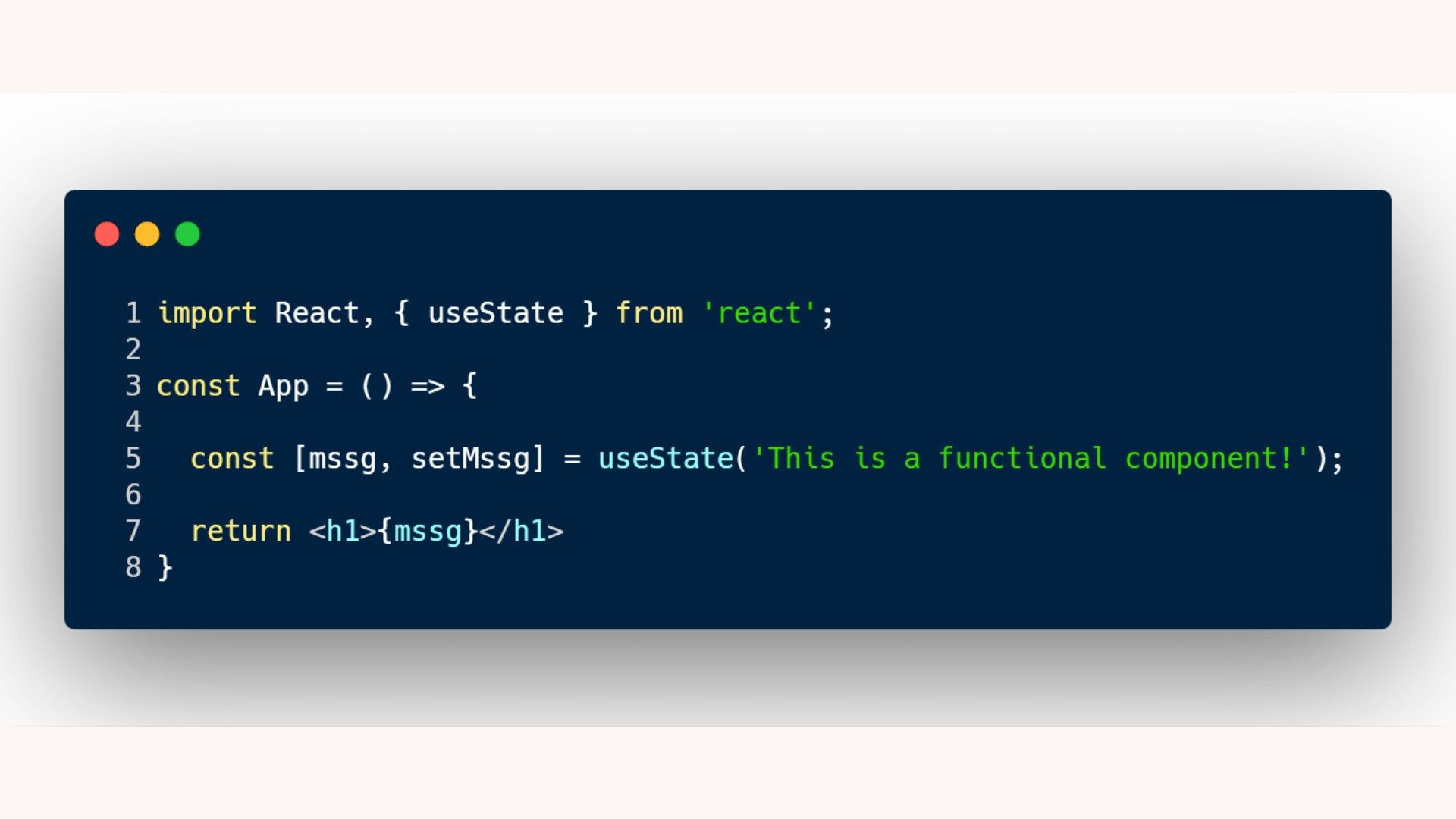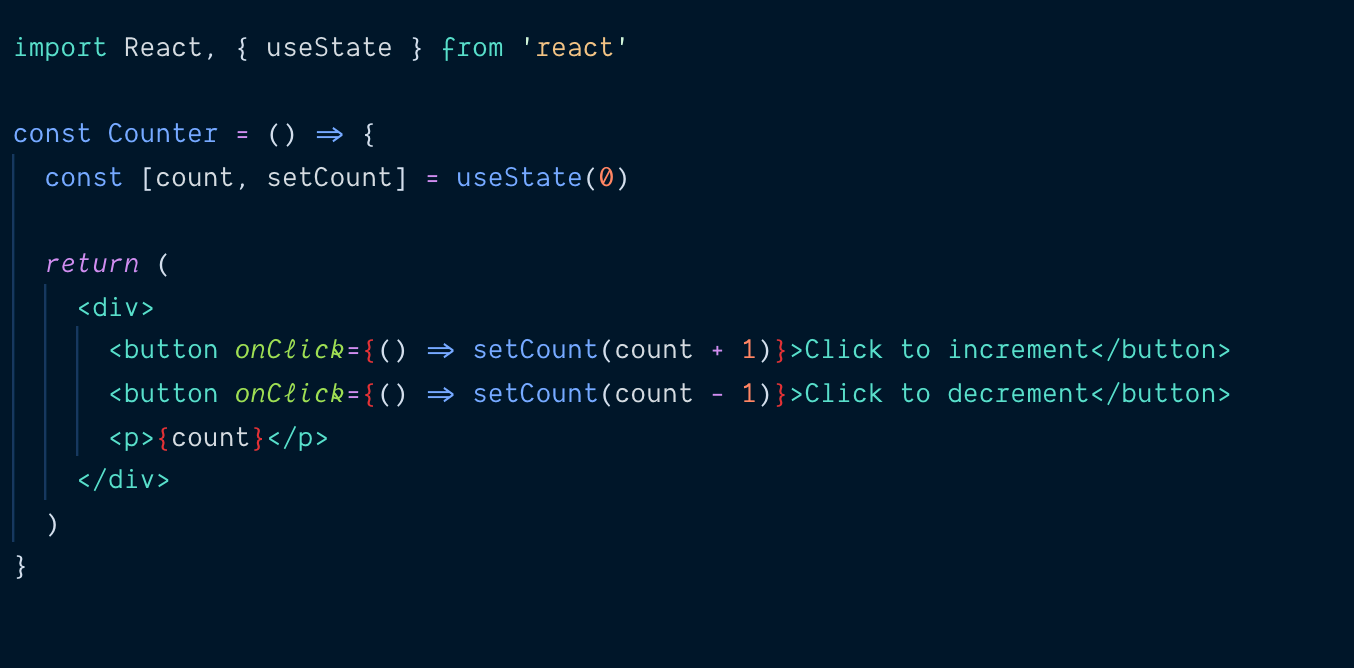Antwort How does useState work? Weitere Antworten – How does useState actually work
The useState() hook works by handling and managing state in your applications. The useState() hook takes the first (initial) value of the state variable as its argument. The second value then sets your state, which is why it's always initiated as setState .Internal working of useState hook
useState() creates a new cell in the functional component's memory object. New state values are stored in this cell during renders.useState is React Hook that allows you to add state to a functional component. It returns an array with two values: the current state and a function to update it. The Hook takes an initial state value as an argument and returns an updated state value whenever the setter function is called.
How does React implement useState : Call useState at the top level of your component to declare a state variable.
- import { useState } from 'react'; function MyComponent() { const [age, setAge] = useState(28);
- const [name, setName] = useState('Edward'); function handleClick() { setName('Taylor');
- import { useState } from 'react'; function MyComponent() {
What are the disadvantages of useState
Disadvantages of useState
useState can become unwieldy if you need to manage complex state, especially if the state is deeply nested. In such cases, it can be difficult to update the state correctly.
Why we use useState instead of variable : This is a way to “preserve” some values between the function calls — useState is a new way to use the exact same capabilities that this.state provides in a class. Normally, variables “disappear” when the function exits but state variables are preserved by React.
Hooks are functions that let you “hook into” React state and lifecycle features from function components. Hooks don't work inside classes — they let you use React without classes. (We don't recommend rewriting your existing components overnight but you can start using Hooks in the new ones if you'd like.)
Hooks are functions that let you “hook into” React state and lifecycle features from function components. Hooks don't work inside classes — they let you use React without classes. (We don't recommend rewriting your existing components overnight but you can start using Hooks in the new ones if you'd like.)
Why not to use useState in React
Commonly, forms in React are managed by linking input elements to state variables, updating the state with every keystroke. While this approach works, it can lead to unnecessary re-renders and performance issues, especially in large forms or complex applications.TL;DR: useState is an asynchronous hook and it doesn't change the state immediately, it has to wait for the component to re-render. useRef is a synchronous hook that updates the state immediately and persists its value through the component's lifecycle, but it doesn't trigger a re-render.The useState hook allows functional components to have stateful logic, while the useEffect hook allows performing side effects. useContext hook allows for the consumption of data through the component tree.
Redux and React Hooks should be seen as complements and also as different things. While with the new React Hooks additions, useContext and useReducer, you can manage the global state, in projects with larger complexity you can rely on Redux to help you manage the application data.
Why we use Redux instead of useState : The application's complexity: For simple apps with few components, use useState() . For complex apps with extensive state interactions, choose Redux . Team size and skill level: useState() is okay for smaller teams or developers new to state management because it's easy to understand.
What is better than useState : useReducer also lets you optimize performance for components that trigger deep updates because you can pass dispatch down instead of callbacks. This means that the dispatch function does not change between renders, unlike the functions created by useState , which can cause unnecessary re-renders of child components.
Is Redux outdated
Looking ahead to the present day, the React ecosystem has expanded significantly, prompting the question: Is Redux still a necessity In most instances, the answer is: No! You are no longer obligated to turn to Redux as the default method for handling state in your React applications.
The application's complexity: For simple apps with few components, use useState() . For complex apps with extensive state interactions, choose Redux . Team size and skill level: useState() is okay for smaller teams or developers new to state management because it's easy to understand.Team size and skill level: useState() is okay for smaller teams or developers new to state management because it's easy to understand. Redux can be good for larger teams with experienced developers. Sharing State: Redux centralized state management is easier to use in some cases than useState() .
Why use useState instead of variables : The reason is if you useState it re-renders the view. Variables by themselves only change bits in memory and the state of your app can get out of sync with the view. In both cases a changes on click but only when using useState the view correctly shows a 's current value.








